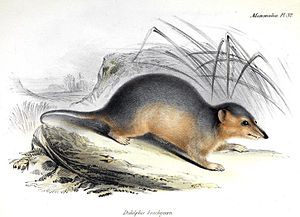Yellow-flanked shrew pouch rat
| Yellow-flanked shrew pouch rat | ||||||||||||
|---|---|---|---|---|---|---|---|---|---|---|---|---|

Yellow-flanked shrew pouch rat ( Monodelphis dimidiata ) |
||||||||||||
| Systematics | ||||||||||||
|
||||||||||||
| Scientific name | ||||||||||||
| Monodelphis dimidiata | ||||||||||||
| ( Wagner , 1847) |
The yellow-flanked shrew-pouch rat ( Monodelphis dimidiata ), also known as the orange- flanked shrew -pouch rat , lives in southern Brazil, Uruguay , south-eastern Paraguay and northern Argentina.
description
Males reach a head body length of 9.5 to 15.4 cm and have a 3.7 to 7.6 cm long tail. Females stay slightly smaller with a head body length of 8.8 to 13 cm and a 3.8 to 5.7 cm long tail. The weight of the animals is 40 to 84 g. Yellow-flanked shrew pouch rats show a strong sexual dimorphism in terms of size . Females, on average, only reach 40% the weight of the males, but can reach 85% the length of the males. The skull and canines are also significantly larger in the male. The hairless tail of the animals has a length of 40 to 45% of the length of the head. The fur on the back, the head, and the outsides of the limbs are unstriped and ashen gray or olive brown. The sides of the body are orange. There are no dark circles under the eyes or a dark stripe in the middle of the head and muzzle. The peritoneum is light brownish or orange-brown. The fur is short and soft. Females do not have a pouch. The number of teats is unknown, but females with a maximum of 16 pups have been observed. In the yellow-flanked shrew-pouch rats living in southeastern Brazil, which were originally described as an independent species under the name Monodelphis sorex , 27 teats were counted, 13 on each ventral side and one in the middle. This is the highest number of teats in any opossum species. In these animals, the tail has a length of approx. 60% of the length of the head and their flanks are rather rust-colored to reddish. The karyotype of the yellow-flanked shrew pouch rat is 2n = 18, FN = 30.
Habitat and way of life
The yellow-flanked shrew-pouch rat lives in the pampas , on pastures, in swamps, on river banks and in rocky areas. The greatest population densities of the species are found in dense grass stands. The specimens originally attributed to Monodelphis sorex also live in southeastern Brazil in the Atlantic rainforest and in cultivated areas. The yellow-flanked shrew pouch rat is diurnal, has its main activity during the late afternoon and is largely ground-dwelling. Specimens kept in human care have shown that the species can climb well, using its short tail, and is also active during the night.
The yellow-flanked shrew-pouch rat feeds primarily on insects, as well as on small vertebrates and plant matter. In one study, all stomachs contained remains of insects, remains of vertebrates, mostly small mammals, were found in a third of the stomachs, and 9% of stomachs contained plant matter, often the seeds of ant trees and blackberries . The small mammals that are captured include the little vesper mouse ( Calomys laucha ), the yellow-brown pygmy rice rat ( Oligoryzomys fulvescens ), the Robert grave mouse ( Oxymycterus roberti ) and Necromys obscurus . Commonly eaten insects include ants, beaked beetles, hymenoptera , cockroaches, caterpillars and grasshoppers. Other invertebrates that are eaten are snails, leeches, earthworms, woodlice and other crustaceans, harvestmen and mites. Hairy caterpillars are rolled with their paws on the ground to remove the hair. Some females kept in human care shied away from killing offered house mice , and if they did, then only from young mice. Males are more aggressive and show no inhibitions about killing mice. When eating, the animals use their front paws and position the food so that it can be reached by their back molars.
Yellow-flanked shrew-pouch rats breed only once in their life ( semelparity ). The females usually have 8 to 14, a maximum of 16 young animals that weigh 0.08 to 0.11 g at birth. They are born in a nest made of leaves. The leaves needed to build the nest are transported by the female with her tail to the building site. The breeding season in Argentina is in spring.
Systematics
The German zoologist Johann Andreas Wagner , who described it in 1847 under the name Didelphis dimidiata , is considered to be the author of the first description of the yellow-flanked shrew pouch rat . Monodelphis henseli and Monodelphis sorex are synonym descriptions of Monodelphis dimidiata . Together with the single-stripe shrew pouch rat ( M. unistriata ) from southeastern Brazil, the yellow-flanked shrew pouch rat forms the subgenus Monodelphiops in the genus Monodelphis .
status
The three-lined shrew pouch rat is considered safe by the IUCN . It has a large distribution area, is also found in some protected areas and generally does not seem to tolerate extensive changes in its habitat by humans.
supporting documents
- ↑ a b c d e f g Diego Astúa: Family Didelphidae (Opossums). in Don E. Wilson , Russell A. Mittermeier : Handbook of the Mammals of the World - Volume 5. Monotremes and Marsupials. Lynx Editions, 2015, ISBN 978-84-96553-99-6 . Page 154.
- ↑ Silvia E. Pavan, Robert S. Voss: A revised subgeneric classification of short-tailed opossums (Didelphidae, Monodelphis). American Museum novitates 3868, 2016.
- ↑ Monodelphis dimidiata in the endangered Red List species the IUCN 2018 Posted by: Teta, P. & Martin, GM, 2015. Retrieved on July 3 of 2019.
